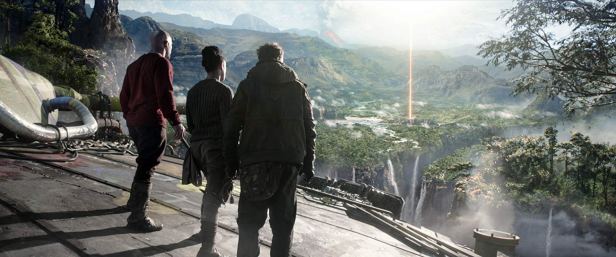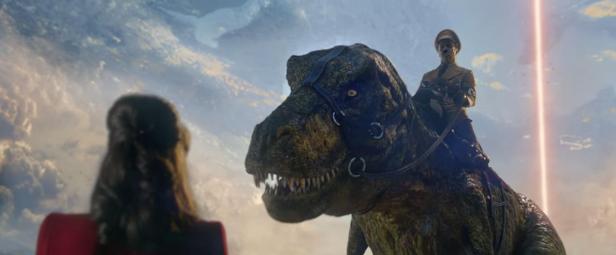Those pesky moon Nazis are back, albeit in a rather different form, in Timo Vuorensola’s follow-up to his sleeper hit Iron Sky (2012). This time they play second fiddle to a ridiculous plot about shape-changing lizard creatures from the centre of the Earth who have been running the world for centuries, Dalan Musson’s screenplay drawing inspiration from the Vril conspiracy theory first suggested by Edward Bulwer-Lytton’s 1871 novel The Coming Race and, perhaps, from Edgar Rice Burroughs’ Pellucidar series (At the Earth’s Core (1914), Pellucidar (1915), Tanar of Pellucidar (1929), Tarzan at the Earth’s Core (1929), Back to the Stone Age (1937), Land of Terror (1944) and Savage Pellucidar (1963)).
In the year 2047, 29 years after the events of the first film, a nuclear war between the Earth and the Moon Nazis has destroyed the planet . The last handful of survivors have fled to the former Nazi base on the dark side of the moon, now renamed Neomenia, ruled over by a now aged Renate Richter (Julia Dietze). The Earth people and the remaining Moon Nazis live in uneasy peace but the base is deteriorating – overpopulated and short on natural resources, the base is facing destruction until a group of Russians arrive aboard a home-made spacecraft, bringing with them the former Moonführer Wolfgang Kortzfleisch (Udo Kier) who wasn’t killed as the first film suggests. In fact he’s a a Vril, one of a a race of reptilian aliens that arrived on Earth in prehistoric times and who created the human race when he injected the life-restoring substance into his pet monkeys Adam and Eve. The Vril have been living in a city at the centre of the Earth and Kortzfleisch persuades Obi Washington (Lara Rossi), the daughter of Renate and the now dead American astronaut James Washington, to visit the Vrilian city of Agartha to find a new home for her people. Obi leads a mission with Russian pilot Sasha (Vladimir Burlakov), Neomenia security officer Malcolm (Kit Dale) and members of a religious cult, the Jobsists, who worship Steve Jobs and his Apple products, to the Hollow Earth where they learn that world leaders like Caligula, Margaret Thatcher, Adolf Hitler and the last Sarah Palin-esque President of the United States (Stephanie Paul) were all Vrilians who are now planning to attack the moon colony aboard a fleet of flying saucers of their own.

With the surprise of the first film’s outlandish plot and breath-taking visuals now gone, The Coming Race just looks silly and amateurish, a bizarre mish-mash of ideas that never even comes close to gelling into a coherent narrative. The comedy is even broader this time, the satire blunter and even less focused that it was in Iron Sky – for example, there’s no doubt that Steve Jobs, Apple and the almost cult-like devotion to their products was in dire need of parodying but it’s all very on the nose, far too obvious to be really effective. When the Jobsists discover their “messiah” is a Vrilian, the reptilian Jobs eats them alive. And that’s about as subtle as the satire gets this time around.
In his book The Coming Race, Edward Bulwer-Lytton wrote about an expedition to an underground world populated by the telepathic Vril-ya and the decades since his ideas have taken on a life of their own and have become the centrepiece of a typically absurd conspiracy theory that suggests that Bulwer-Lytton was telling the truth and that there really is a race of powerful aliens living at the heart of a Hollow Earth. Similarly, the fabled city of Agartha, first mentioned by Nineteenth-century French occultist Alexandre Saint-Yves d’Alveydre, has assumed proportions far beyond its original status in an age when a need to believe in something – anything – has seen the rise of the conspiracy theory to worrying levels. The script further stirs in the ludicrous beliefs of former British sports journalist David Icke that the Earth is being secretly run by the an inter-dimensional reptilian race known as the Archons.

The Coming Race reeks of desperation, of Vuorensola trying too hard to top the first film. To be fair, he set the bar very high in terms of outre silliness and there was really nowhere left to go here. Adolf Hitler riding a dinosaur, a mini sun powering the city at the centre of the Earth and a provocative parody of Da Vinci’s The Last Supper are all startling images – and once again the effects are magnificent – but they’re just brief stops on a narrative journey that ultimately goes nowhere. The decision to abandon the outrageous Nazis-on-the-moon plot of the first film – they barely feature in this film and when they do they’re a much toned down and neutered version – was a baffling one as it was the primary selling point of Iron Sky.
The journey to Agartha and Obi’s quest to steal the Holy Grail is a curiously dull affair that has you fidgeting uncomfortably, waiting for the action to get back to the moon. When it finally does, it’s too little, too late. There are some spectacular battle scenes but nothing here to match the glorious sight of a fleet of interplanetary Zeppelins heading for Earth towing asteroids that figured so strongly in the first film. It feels, dare we say it, a bit ordinary, a bit mundane, a more traditional action film that looks like any number of Hollywood movies, entirely lacking all the things that made Iron Sky so unique. It lacks the off-kilter, almost surreal vibe of the first film and emerges as something disappointingly ordinary.
The film ends with a trip to Mars and as of 2019, Vuorensola is promising/threatening a third installment in the saga, provisionally titled The Ark: An Iron Sky Story in which those other great bogeymen of modern conspiracists, the Illuminati, will play a prominent part. One can only hope that he rediscovers the weirdness, the sharp satire and the glorious steampunk aesthetic of the original film.